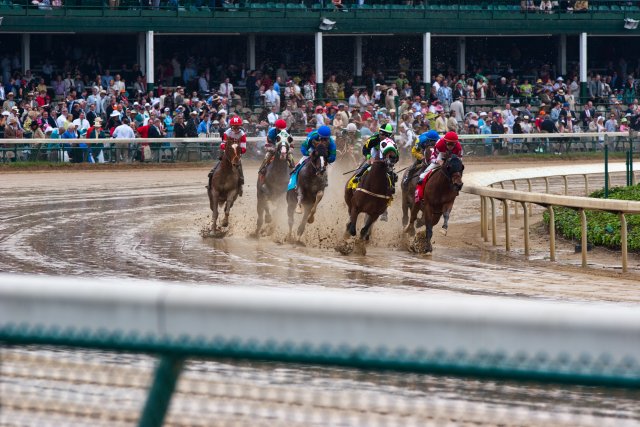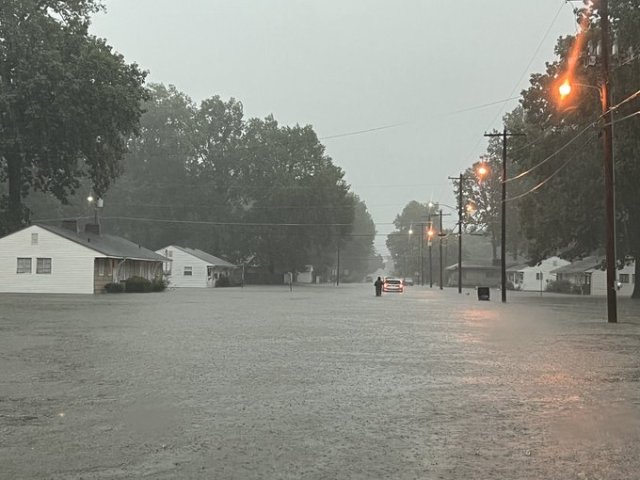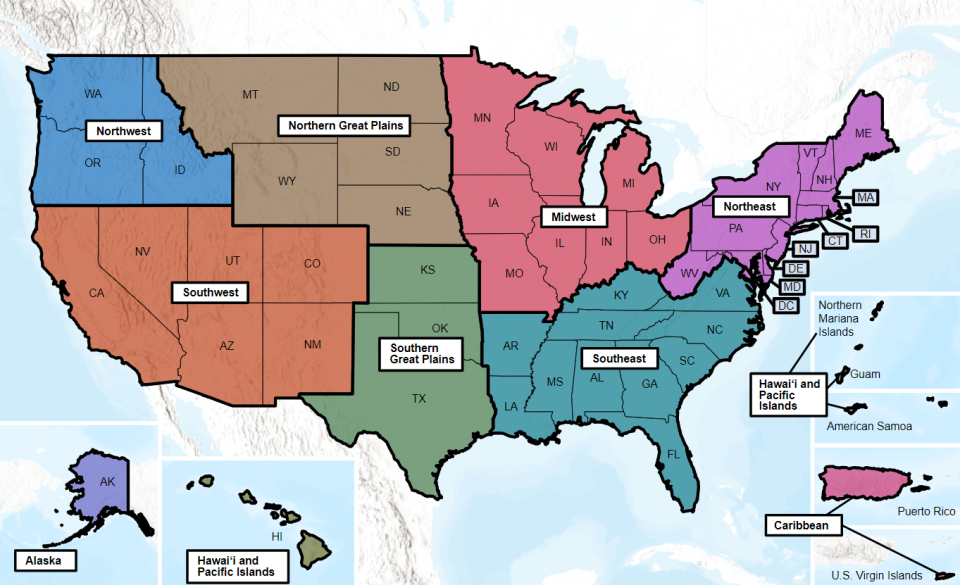Climate Change Connections: Kentucky (Thoroughbred Horses)
Climate change is impacting all regions and sectors of the United States. The State and Regional Climate Change Connections resource highlights climate change connections to culturally, ecologically, or economically important features of each state and territory. The content on this page provides an illustrative example. As climate change will affect each state and territory in diverse ways, this resource only describes a small portion of these risks. For more comprehensive information about regional climate impacts, please visit the Fifth National Climate Assessment and Climate Change Impacts by Sector.
On this page:
Introduction: Thoroughbred Horses Play an Important Role in Kentucky’s Culture and Economy

Kentucky is well known for its rolling hills of bluegrass and iconic Thoroughbred horses, which are the state horse breed. Horseback riding and competitions are a popular pastime and play a role in state culture. Horse-related industries also contribute substantially to Kentucky’s economy. In 2022, there were over 30,000 equine operations in the state, and associated industries supported nearly $2 billion of revenue and more than 12,000 jobs.1
The state’s most well-known horse race, the Kentucky Derby, is often considered the longest-running sporting event in the United States and has taken place every year since 1875. On the first Saturday of May each year, around 150,000 people head to the Churchill Downs racetrack in Louisville, Kentucky, to watch this famous race.2 This influx of people during the Derby brings in an estimated $400 million to the Louisville metropolitan area each year.2
Climate Impacts: Heavy Rain and Flooding Can Affect Humans and Horses Alike
Climate change can affect precipitation frequency and intensity. As average temperatures at the Earth’s surface rise, more evaporation and transpiration add more moisture to the air, which in turn increases overall precipitation. Since the mid-20th century, rainfall extremes or heavy precipitation events have increased in the contiguous United States.3 In recent years, a larger percentage of precipitation has fallen in the form of intense single-day events.4

Kentuckians are already experiencing more catastrophic flooding than in the past. Since tracking began in 1980, all four of the billion-dollar flooding disasters to affect Kentucky occurred in 2010 or later.5 With continued climate change, Kentucky is expected to experience more precipitation, especially during the winter and spring.6 Heavy precipitation events are also expected to happen more often and be more intense.6 These changes could make flooding more common, which can have devastating impacts on local communities, ecosystems, and economies.
Flooding also presents challenges for horses and other livestock. During flooding, horses can become injured or stranded. Flooding can also create conditions, such as standing water, that can attract pests, such as mosquitos, which can lay eggs and spread diseases, including eastern and western equine encephalomyelitis and West Nile virus that can be harmful to humans and horses.7 In July 2023, nearly 11 inches of rain over a two-day period in Kentucky broke some local rainfall records and resulted in flash flooding that destroyed homes and displaced residents.8 The aftermath of the storm also created a myriad of issues for farms and horse operations. Grass fields were flooded and animals did not have anything to graze on, and fences were washed away, making it hard to keep animals contained.9
Heavy precipitation can also alter dynamics of horse-racing events such as the Kentucky Derby with muddier track conditions. If the track becomes too waterlogged (“sloppy” conditions), it becomes harder for horses to run and the race can slow down.10 Each horse also has a different performance history for varying types of track conditions, so the track condition on a rainier day could benefit certain horses.
Warming Temperatures Can Affect Horse Health
As concentrations of heat-trapping greenhouse gases in the atmosphere continue to increase, the United States is experiencing warming temperatures. While Kentucky has not warmed as much as most other states since the beginning of the last century, its warmest five-year period occurred from 2016 to 2020, and unprecedented warming is projected over the 21st century.6
Hot and humid conditions, especially during strenuous exercise, can contribute to heat stress in horses.11 High humidity also makes sweating less efficient at releasing body heat, which can make it harder for horses to cool off and can affect their performance and health.12 The core body temperature of Thoroughbred racehorses can increase rapidly during a race, at almost 2°F per minute.3,13 If their body temperatures rise above a certain threshold, the horses can experience dangerous heat illness.
Taking Action: Preparing for More Flooding and Heat
Addressing climate change requires reducing greenhouse gas emissions while preparing for and protecting against current and future climate impacts. Communities, public officials, and individuals in every part of the United States can continue to explore and implement climate adaptation and mitigation measures. In Kentucky, many in the horse industry are taking steps to prepare for changing conditions, including:
- Preparing for flooding. Given the predictions of increased extreme precipitation events and associated flooding, disaster preparedness on farms and equine operations is important. Having appropriate supplies and adequate amounts of food and water in case floods and blocked roadways cut off access to resources can help manage risks.7 Additionally, staying up to date on appropriate vaccinations to manage waterborne illnesses or pests can help mitigate some of the hazards associated with flooding.
- Keeping horses cool. With warming temperatures, keeping horses cool can help prevent heat illness. Showering horses continuously with water or directing fans at them have been shown to be efficient strategies to cool horses down after a race.12
To learn more about climate change impacts in Kentucky and the Southeast region, see Chapter 22 of the Fifth National Climate Assessment.
Related Resources
- EPA Climate Change Indicators: Seasonal Temperature
- EPA Climate Change Indicators: Heavy Precipitation
- Kentucky State Climate Summary 2022 (NOAA)
References
1 Stowe, J. (2023, July 28). Highlights of the 2022 Kentucky Equine Survey. Department of Agricultural Economics, University of Kentucky. Retrieved February 23, 2024, from https://agecon.ca.uky.edu/highlights-2022-kentucky-equine-survey
2 Lambert, T. E. (2023). Horse sense or horse hype? Estimating the true economic impact of Churchill Downs and the Kentucky Derby on the Louisville Metro Area. Faculty Scholarship. https://ir.library.louisville.edu/faculty/869
3 Marvel, K., Su, W., Delgado, R., Aarons, S., Chatterjee, A., Garcia, M. E., Hausfather, Z., Hayhoe, K., Hence, D. A., Jewett, E. B., Robel, A., Singh, D., Tripati, A., & Vose, R. S. (2023). Ch. 2. Climate trends. In A. R. Crimmins, C. W. Avery, D. R. Easterling, K. E. Kunkel, B. C. Stewart, & T. K. Maycock (Eds.), Fifth National Climate Assessment. U.S. Global Change Research Program. https://doi.org/10.7930/NCA5.2023.CH2
4 EPA. (2024). Climate change indicators: Heavy precipitation. Retrieved August 1, 2024, from https://www.epa.gov/climate-indicators/climate-change-indicators-heavy-precipitation
5 National Centers for Environmental Information. (2024). Billion-dollar weather and climate disasters. https://doi.org/10.25921/stkw-7w73
6 Runkle, J., Kunkel, K. E., Champion, S. M., Frankson, R., & Stewart, B. C. (2022). Kentucky state climate summary 2022 (NOAA Technical Report NESDIS 150-KY). NOAA National Environmental Satellite, Data, and Information Service. https://statesummaries.ncics.org/chapter/ky/
7 Camargo, F., Coleman, B., & Dwyer, R. (n.d.). Equine Emergency and Disaster Preparedness. Department of Animal & Food Sciences Martin-Gatton College of Agriculture, Food and Environment. Retrieved February 23, 2024, from https://afs.ca.uky.edu/content/equine-emergency-and-disaster-preparedness
8 National Weather Service. (n.d.). Summary of historic flash flooding on July 19, 2023. Retrieved August 1, 2024, from https://www.weather.gov/pah/FloodingJuly19_2023
9 Wiemers, H. (2022, October 12). UK and equine industry partners respond to horses in need after Eastern Kentucky flooding. University of Kentucky, Martin-Gatton College of Agriculture: College News. Retrieved February 23, 2024, from https://news.ca.uky.edu/article/uk-and-equine-industry-partners-respond-horses-need-after-eastern-kentucky-flooding
10 Maeda, Y., Tomioka, M., Hanada, M., & Oikawa, M. (2012). Influence of track surface condition on racing times of Thoroughbred racehorses in flat races. Journal of Equine Veterinary Science, 32(11), 689–695. https://doi.org/10.1016/j.jevs.2012.02.012
11 Kang, H., Zsoldos, R. R., Sole-Guitart, A., Narayan, E., Cawdell-Smith, A. J., & Gaughan, J. B. (2023). Heat stress in horses: a literature review. International Journal of Biometeorology, 67(6), 957–973. https://doi.org/10.1007/s00484-023-02467-7
12 Takahashi, Y., Ohmura, H., Mukai, K., Shiose, T., & Takahashi, T. (2020). A comparison of five cooling methods in hot and humid environments in Thoroughbred horses. Journal of Equine Veterinary Science, 91, 103130. https://doi.org/10.1016/j.jevs.2020.103130
13 Brownlow, M., Dart, A., & Jeffcott, L. (2016). Exertional heat illness: a review of the syndrome affecting racing Thoroughbreds in hot and humid climates. Australian Veterinary Journal, 94, 240–247. https://doi.org/10.1111/avj.12454

